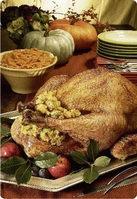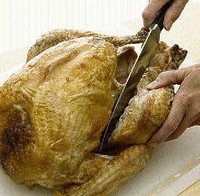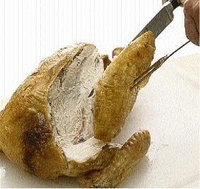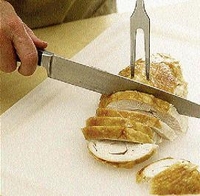
Some supermarkets sell a variety of turkey options for your Thanksgiving feast. - MCT Photos
It's that time of the year when we again think about turkey and the celebration of the American tradition, Thanksgiving, now celebrated in many homes in Jamaica by Americans and Jamaicans alike. You may travel to the United States to enjoy your mother's Thanksgiving dinner every year.
I would hardly miss Desna Foster's special Thanksgiving Dinner in Windsor, Connecticut. It has people travelling from far to enjoy her blend of American and Jamaican dishes from her homely kitchen where she prepares for more than 80 persons.
You can make your Thanksgiving dinner special too. Like any other celebration, it means pulling food together for a meal, and usually the turkey forms the centrepiece. You may be a first-timer in preparing the turkey this year or, if you are accustomed to doing the turkey, you can refresh your mind with tips and guidelines as we talk turkey.
What will you serve?
Your menu should be inspired by what you like to prepare, including family favourites and some new classics. Suggestions include turkey and sides:
Orange-scented Roast Turkey: The heady scent of oranges, aromatic vegetables and roasting turkey wafts through the house for a homely feel.
Turkey with Port Wine Sauce and Rice Stuffing: Give your turkey dinner an elegant makeover by serving with rice-stuffing recipe and adding a delicious, decadent port wine sauce.
Sorrel Ginger Chutney: Turkey is traditionally served with cranberry sauce, but the Jamaican twist - a healthy dose of ginger and sorrel - is a combination not to be missed. The sorrel chutney produced by through the Scientific Research Council should grace your table this year.
Balsamic-roasted Sweet Potato Wedges: The flavours of balsamic vinegar and brown sugar create the perfect glaze for this already sweet vegetable.
Sweet Potato and Peanut Stew: A tasty vegetarian dish with tomatoes, warm spices and a touch of peanut butter. Microwaving the sweet potatoes helps you finish in a flash.
Harvest Casserole: A great dish to accompany a holiday turkey or ham. Vegetarians will also appreciate this meat-free, yet filling recipe.
(Hearst Communications, Inc)
Cook Stuffing Outside the Cavity of the Turkey
Do not cook the stuffing inside the bird. The cavity of a turkey is the perfect place for bacteria to thrive and multiply so it is not safe to cook the turkey stuffing inside the bird. Instead, bake the stuffing in a separate casserole dish. The high temperatures will prevent bacteria growth. The centre of the dressing inside the bird if you do stuff it or bake it in a separate baking dish must reach a temperature of 165F for food safety.
Buying Your Turkey
The first thing to do is to have a bird in hand, so if you are not getting a turkey, you will have no choice but to purchase the bird. There are several types of birds to choose from - fresh, frozen, organic, among others. It is advisable to avoid self-basting turkeys, which are often injected with butter or other fat and may have additives such as MSG.
Frozen: Turkeys labelled frozen are flash-frozen down to 0F right after processing. They are just as flavourful as fresh ones. If you purchase a frozen turkey, allow plenty of time for it to thaw in the refrigerator or up to 12 hours in a sink in very cold water, making sure to change the cold water every 30 minutes. For food safety, never thaw your turkey at room temperature - in the sink or on the kitchen counter.
Self-basting turkeys are injected with solutions to enhance flavour and sold in a frozen state.
Fresh: Fresh turkeys are kept at a temperature below 40F and above 26F and, therefore, have a shorter shelf life than frozen turkeys. They do not need thawing, which makes them more convenient to use.
Organic: Organic turkeys, often called free-range, are raised on organic feeds and are raised without antibiotics. They are allowed to run freely around and get plenty of sunshine, fresh air and exercise. Organic turkeys come frozen or fresh.
How much to buy?
A huge challenge in buying the turkey is to know how much to purchase for your celebration. First, you have to identify how many persons will be dining, then allow 1 to 11/2 pounds of turkey per person. You can select the type of turkey you want and place it in you freezer. (dailydish@southbeachdiet.com)
HISTORY & TRADITION
Why are we so hooked on this Thanksgiving tradition? Though there is no real evidence that turkey was served at the Pilgrims' first Thanksgiving, over time it has become an indispensable part of the Thanksgiving tradition. The tradition of turkey is rooted in the History of Plymouth Plantation, written by William Bradford some 22 years after the actual celebration. In his letter sent to England, Edward Winslow, another Pilgrim, describes how the governor sent "four men out fowling" and they returned with turkeys, ducks and geese.
Unfortunately, the Bradford document was lost after being taken away by the British during the War of Independence. It was rediscovered in 1854. Since then turkey turned out to be the most popular symbol of the Thanksgiving Day. (TheHolidaySpot.com)
The turkey
The wild turkey is native to northern Mexico and the eastern United States. Later, it was domesticated in Mexico and brought to Europe early in the 16th century. According to
Roast Turkey with Molasses Glaze
1 (16lb) fresh turkey
1 tbsp sage, chopped
1 tbsp thyme, chopped
Salt and fresh pepper, to taste
2 onions, chopped
3 carrots, chopped
2 ribs celery, chopped
3 tbsps molasses
3 tbsps soy saucek
1 tbsp Dijon mustard
Preheat the oven to 325F. Rinse the turkey inside and out with cold water. Dry thoroughly with paper towels. Season inside and out with sage, thyme, salt and pepper. Stuff turkey loosely with your favourite stuffing and truss. Place the turkey in a roasting pan with the chopped vegetables and place in the centre of the oven. In a bowl, whisk the molasses, soy and mustard together. During the last two hours of roasting, baste the turkey every 20 to 30 minutes with the molasses mixture. The skin will become dark. Tent with foil if necessary. The turkey should take approximately 41/2 hours to cook. Let the turkey rest for 20 to 25 minutes before carving.
Source: www.foodgeeks.com/recipes/4764
Chinese Turkey Vegetable Casserole
Chinese vegetables and mushrooms give this turkey casserole its Oriental slant.
1lb French-cut string beans, drained
1lb Chinese mixed vegetables, drained
1 can (81/2oz) water chestnuts, sliced and drained
1 can (8oz) sliced mushrooms, drained
1 small onion, chopped
1 cup grated Cheddar cheese
4 cups cubed cooked turkey (or chicken)
1 can (103/4oz) cream of mushroom soup
1oz sherry
1 cup milk
2 onions, cut in rings
Alternate layers of vegetables, cheese and turkey in greased 9x13-inch casserole.
Combine soup, sherry and milk. Pour over casserole.
Cover loosely with foil. Bake at 350F for 40 minutes.
Remove foil; sprinkle onion rings on top. Bake 20 minutes longer.
Serves 6 to 8
(Source: About.com: Homecooking)
Bringing the HolidaySpot.com, the late Benjamin Franklin, the scientist and United States statesman, strongly favoured making the turkey the national bird instead of bald eagle.
When you see a turkey, you cannot miss it. It has brown features with buff-coloured feathers on the tips of the wing and on the tail. The male turkey is called a 'tom'. It is bigger and brighter and more colourful. The fleshy, wrinkled, brightly coloured fold of skin hanging from the neck or throat, known as the wattle, is a distinctive feature of the turkey. The female, called a 'hen', is generally smaller and drab in colour. Thanksgiving/turkey.htm
Thaw in Time
Having bought your turkey, the next challenge is to cook it for the enjoyment of your guests. Plan ahead and thaw your turkey in time. Turkeys take a long time to thaw, so make sure you allow enough time before Thanksgiving to completely thaw the bird. For refrigerator thawing, allow 24 hours for each five pounds of turkey. A 14-pound turkey, for example, should be in the refrigerator three to four days before the holiday; a 20-pounder should be out of the freezer and in the refrigerator four to five days before Thanksgiving. In order to keep your refrigerator tidy during the thawing process, place the turkey (still in the store wrapper) in a shallow pan in the lower shelf.
What if the turkey is not fully thawed on the morning of Thanksgiving Day? Your kitchen sink will come to your rescue. Wash the sink thoroughly and fill with cold water. Place the turkey in the water and change the water every 30 minutes until it is thawed. You may also add some salt to the water. It is important to remember not to thaw the turkey at room temperature on the kitchen counter, as this will increase the bacterial count in the meat.
Allow Enough Roasting Time for the Turkey
High-roast the turkey at 325ºF. If roasting at lower temperatures, allow 20-25 per pound, plus allow another 20 minutes for the turkey to stand (covered in foil) before carving. Do not cook at very low temperatures overnight because this can facilitate bacterial growth.
FOOD SAFETY
Cook stuffing outside: Do not cook the stuffing inside the bird. The cavity of a turkey is the perfect place for bacteria to thrive and multiply, so it is not safe to cook the turkey stuffing inside the bird. Instead, bake the stuffing in a separate casserole dish. The high temperatures will prevent bacterial growth. The centre of the dressing inside the bird - if you do stuff it or bake it in a separate baking dish - must reach a temperature of 165ºF for food safety.
Use a food thermometer: Place it at an angle near the leg but not touching the bone. You will know that the turkey is done when the internal temperatures reach 165ºF. Be careful of the pop-up timers packaged with the turkey as the probe is too short to penetrate the thicker parts of the bird in the test for doneness.
Keep food at proper temperature: During Thanksgiving dinner, it is easy to forget how long foods are being kept at room temperature. Clear foods away after the meal is over and refrigerate any leftovers promptly. Keep foods at the proper temperatures. Keep hot foods hot and cold foods cold. (http://seasonalcooking.suite101.com)
Heather Little-White, PhD, is a nutrition and lifestyle consultant in Kingston. Send comments to saturdaylife@gleanerjm.com or fax 922-6223.
Cutting to the chase

Hold end of drumstick and cut through meat between thigh and body. Pull drumstick away from body and remove by cutting through joint where thigh connects to body. Separate thigh from drumstick by cutting through joints that hold them together.

Steady the bird with carving fork and cut horizontally into the breast just above the wing. Remove the entire breast by cutting from the top of the bird down to the horizontal cut, using the breastbone as a guide for your knife.

Put the breast on a cutting board and slice meat in even pieces. Carve the thigh and drumstick in slices if desired. Arrange turkey slices on a serving platter.